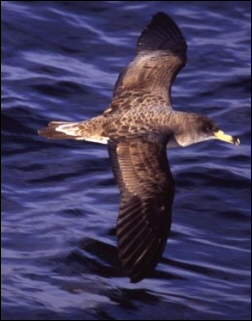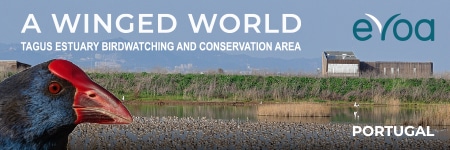Autonomous Region of the Azores

Birding the Azores
The Azores are a group of nine islands that form a semi-autonomous part of Portugal. They are situated in the northern Atlantic west of Portugal, roughly one third of the distance to North America. The islands are in three groups – Flores and Corvo in the west, a central group consisting of Faial, Sao Jorge, Graciosa, Terceira and Pico, and Sao Miguel and Santa Maria in the east. The most developed islands are Sao Miguel and Terceira, and to a lesser extent Faial.
Transport between the islands is straightforward except in the winter months when schedules are frequently disrupted by the weather. All the islands have airfields, with flights to Lisbon and a few other international sites departing from Terceira and Sao Miguel. Inter-island flights are operated by TAP and SATA. Ferries operate within the central group year-round and more extensively in the summer season. There are direct flights to The Azores from Scandinavia but mostly flights involve changing in Lisbon, sometimes involving an overnight stay. During the main tourist season at least it is possible to fly between The Azores and Madeira.
The islands attract birders for four main reasons. Firstly, being so much nearer America than continental Europe, and Britain of course, the islands have an excellent record for attracting trans-Atlantic vagrants, especially water birds. One site, a disused coastal quarry at Cabo da Praia on Terceira, has an unrivalled reputation as the best western Palaearctic site for American waders, and birds have been found at many other sites. American birds tend to be found throughout the autumn and often stay for the winter. Secondly, the islands host healthy numbers of breeding seabirds such as Cory’s Shearwater and Roseate Tern, and the colonies have recently been found to harbour individuals of highly sought after species such as Sooty Tern, Red-billed Tropicbird and even Bermuda Petrel. Thirdly, large numbers of migrating sea-birds can be seen, especially in late August and September. And fourthly, there is one Azorean endemic, the Azores Bullfinch, which is found in one area of forest at the eastern end of Sao Miguel; there are also endemic subspecies of several species such as Goldcrest, Grey Wagtail and Chaffinch, amongst others.
Being at the junction of three continental plates the islands are subjected to volcanic activity and earthquakes. The resulting landscape is often spectacular, and the site of the fairly recent eruption at Capelhinos, the western tip of Faial, is particularly memorable, as is the area of caldeiras and crater lakes in central Flores.
Prices on the islands are comparable with mainland Portugal. Roads are generally good, and there is a wide variety of accommodation available. The main tourist season finishes in September, when the weather becomes less settled.
-
Number of bird species: 380
(But most are rarities and vagrants - there are just 64 common or regularly occurring species)
-
iGoTerra Checklist
Portugal (Atlantic)Fatbirder Associate iGoTerra offers the most comprehensive and up to date birds lists on the web
-
A Birdwatchers' Guide to Portugal, the Azores & Madeira Archipelagos
| By Colm Moore, Gonçalo Elias & Helder Costa | Prion | 2014 | Paperback | 212 pages, b/w illustrations, b/w maps | ISBN: 9781871104134 Buy this book from NHBS.com -
Birds of the Atlantic Islands
| By Tony Clarke, Chris Orgill & Tony Disley | Christopher Helm | 2006 | Paperback | 368 pages, 56 colour plates, b/w photos, b/w maps | ISBN: 9780713660234 Buy this book from NHBS.com -
Field Guide to the Birds of Macaronesia
| (Azores, Madeira, Canary Islands, Cape Verde) | By Eduardo Garcia-del-Rey | Lynx Edicions | 2011 | Hardback | 341 pages, 150 colour plates, 230 distribution maps | ISBN: 9788496553712 Buy this book from NHBS.com
-
African Bird Club
WebpageThe archipelago of nine islands in the north Atlantic is well-known for its seabird colonies and holds large populations of Cory’s Shearwater Calonectris diomedea, Little Shearwater Puffinis assimilis, Madeiran Storm-petrel Oceanodroma castro and Roseate Tern Sterna dougallii. -
Portuguese Society for the Study of Birds (SPEA) - BirdLife Partner
WebpageThe Portuguese Society for the Study of Birds (SPEA) is a nonprofit scientific association that promotes the study and conservation of birds in Portugal. It was founded on November 25 of 1993 and corresponds to a desire expressed by a large number of professionals and amateurs that developed activities in the field of ornithology and conservation of Nature. Currently SPEA has about 3500 members and develops projects of nature conservation in national territory and also some in partnership abroad (Cape Verde, Sao Tome, Greece, Spain and Malta).
-
Gerbybirding
Tour OperatorGerbybirding is the first company is the Azores specialized in birdwatching. We are a small company, offering a personalized service to small groups, and we are as comfortable working with a curious observer as well as accompanying experienced ornithologists. Your personal “birdguide” will be Gerbrand Michielsen, better known as Gerby, which will take you to the best spots in São Miguel island, by car, on foot or by kayak – an unforgettable experience! -
Terra Azul Azores
Tour OperatorTerra Azul Azores is an Ecotourism Tour Operator, fully licensed to operate year-round Whale Watching & Swimming with Dolphins tours, Family & Private tours, Marine Birdwatching tours, and Scientific Expeditions for fellow researchers, photography, and video professionals.
-
2015 [12 December] - Nick Watmough - São Miguel
PDF Report...The lake margins held 2 Eurasian Wigeon, 7 Eurasian Teal and a drake Green-winged Teal. After a couple of hours I headed further east and about 5km beyond Povoação I saw my first Azores Bullfinch flying along the roadside; inevitably there was nowhere to pull in. Turning off onto the unsurfaced road to Nordeste I parked after about 3km and birded up and down the road with no success.... -
2015 [12 December] - Santi Guallar - São Miguel
PDF Report...Azores is an emerald island with high land bird densities: buzzards, chaffinches, canaries, robins,goldcrests, blackbirds and starlings are ubiquitous and tame. Woodpigeons, on the other hand, areshy, probably as a result of hunting pressure. Native vegetation have been largely cleared for cowpastures or supplanted by cryptomeria forests, which explains why Azores Bullfinch, the priolo, isendangered but also tells about the adaptivity of the other native passerines.... -
2015 [12 December] - Santi Guallar - São Miguel
Report...We booked our trip 2 months in advance, but we strongly recommend you plan your trip to Azores on a much shorter term and take into account the weather forecast. We faced very unfavourable weather conditions: rained almost all day long and winds were moderate even with strong gusts until the 27th, especially at high elevations were fog was also present.... -
2016 [10 October] - Tim & Carol Inskipp
PDF ReportIllustrated list -
2017 [05 May] - Mark Graham - Cruise
Report -
2018 [10 October] - Dominic Mitchell
PDF ReportThis beautiful Atlantic archipelago was little visited by birders until the last decade or so, but it has firmly put itself on the map in recent years with a growing reputation as the Western Palearctic’s number one hot-spot in autumn for regionally rare vagrants - especially for wayward migrants from North America. -
2019 [05 May] - Tom Brereton
PDF Report...This gave the group an opportunity to explore Ponta Delgada in the morning. Tom, Jean and Colin took a walk east along the sea front, where Red Rock Crabs were numerous along with the odd Common Tern and a Little Egret. On the way back to the hotel, Tom found an area of waste ground off Estr. Regional da Ribeira Grande, which was full of colourful arable weeds and other wildflowers, plus Island Canary, Wood Pigeon, Greenfinch, Madeiran Wall Lizards and Clouded Yellow butterflies. As on several of the days, a number of the keener birders in the group scanned the gulls in the harbour as Iceland Gull and Ring-billed Gull had been seen recently, though sadly none were seen over the week... -
2019 [10 October] - Phil Callagher
PDF ReportThis was our first visit to the Azores, a one-week trip in the hope of picking up a few decent Western Palearctic ticks. Owing in part to Hurricane Lorenzo, autumn 2019 was another bumper season on the islands, featuring two firsts for the Western Palearctic: Prothonotary and Connecticut Warblers. Both appeared during the middle two weeks of October (generally recognised as the best fortnight for Nearctic passerines)...
-
Azores Bulfinch
WebsiteSpecies account of this endemic -
Resident Birds of the Azores
WebpageThe Azores islands are an archipelago located in the middle of the Atlantic, ruled by Portugal. Though its fauna and flora are mostly of European origin, many endemic species and subspecies. This short guide aims to help the amateur naturalist get familiar with the Azorean endemic...


